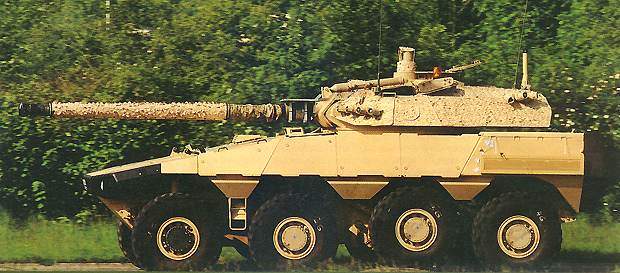The Vextra 105 wheeled armoured reconnaissance vehicle is developed by Nexter Industries (formerly Giat Industries) in Versailles, France. The 8×8 vehicle is capable of anti-tank combat and has fire-on-the-move capability against stationary or moving targets. The vehicle is based on the same wheeled chassis as the Vextra 25 and has demonstrated high tactical and strategic mobility in trials, including desert trials carried out in the United Arab Emirates in October 1997. During the trials, the Vextra 105 covered 200km on very soft sandy tracks at speeds greater than 50km/h, reaching top speeds of 120km/hr on roads.
Gun firing tests were carried out on the 105mm gun, the 7.62mm machine gun and the Galix self-defence system, by day and night, with the Vextra 105 halted and on the move at speeds of 60km/h, against both static and mobile targets.
The reconnaissance vehicle is operated by four crew members – driver, commander, gunner and loader.
A working model of the Vextra 105 armoured vehicle completed a series of successful trials in France, and an extensive series of firepower and mobility trials in the UAE, but this tank destroyer received no production orders, regardless of its performance.
Vextra command system
The vehicle is equipped with a version of the FINDERS (fast information, navigation, decision and reporting system) battlefield management system, developed installed on the Leclerc main battle tank. FINDERS includes a colour map display which shows the positions of the host vehicle, allied and hostile forces and designated targets. Functions include digital mapping, navigation / positioning, graphic / alphanumeric messages, tactical situation reports, automatic updating of overlays, logistic reports and communication network management.
Vextra 105 reconnaissance vehicle armament
The Giat TML 105 stabilised turret installed on the Vextra 105 is a light three-man turret armed with a 105mm CN 105 G2 Nato standard low-recoil gun. The turret’s electro-hydraulic drive was replaced by an all-electric system by SIG of Switzerland. It is controlled by a digital computer and allows the turret and the gun to be finely stabilised.
The gun is fitted with electrical aiming system, muzzle brake, fume extractor and thermal sleeve. Elevation is from -6° to +15°.
The stabilised gun can fire a range of standard Nato ammunition including APFSDS (armour-piercing fin-stabilised discarding sabot) rounds. 12 rounds of ready-to-fire 105mm ammunition are carried with 23 rounds stowed.
Secondary armament on the turret is a coaxially mounted 7.62mm machine gun
Self protection
The armoured vehicle is protected against 14.5mm heavy machine gun rounds and artillery splinters. Modular or reactive armour can be fitted to provide protection against medium calibre and infantry rockets.
Vextra 105 is fitted with the Galix close defence system, which consists of four launchers for 80mm rounds either side of the gun at the front of the vehicle and three on each side at the rear. Types of rounds include: instant smoke screen round (in the visible spectrum), instant wide area smoke round (in the visible and infrared spectrum), illumination round and infrared decoy round.
Fire control and surveillance
The gunner’s station is fitted with the SAGEM Savan 15 three-axis stabilised sight similar to that used on the Leclerc main battle tank.
Savan 15 sensors include a dual field of view thermal imager, high resolution TV channel and laser rangefinder (eyesafe if required) coupled with a digital fire control computer for sensor management and ballistic calculations.
The commander has a stabilised panoramic sight which is controlled by the fire control computer.
Propulsion
The Vextra 105 vehicle has eight drive wheels and is fitted with the Syegon variable tyre pressure system and run flat device and new generation wide dimension tyres. It is powered by a Saab Scania 260 DaN.m diesel engine with Renk HS automatic gearbox and two steered axles. Suspension is hydropneumatic.
Total combat weight is 28t to 34t, depending on the level of ballistic protection. Average road speed is 110km/h and range is greater than 800km on roads at stabilised speed.











